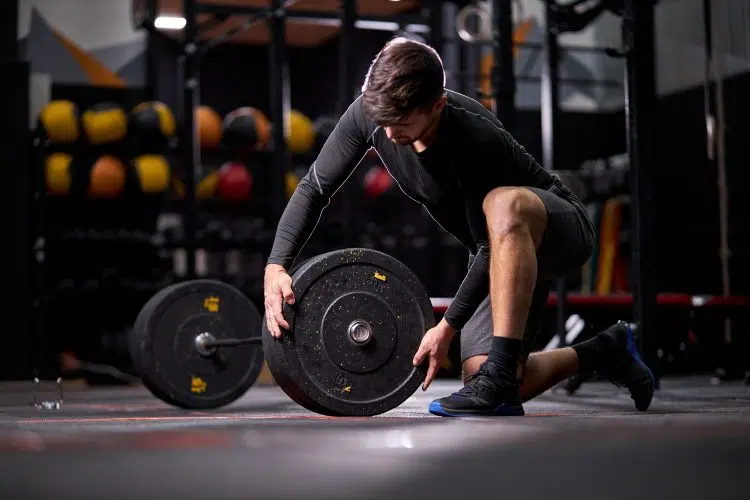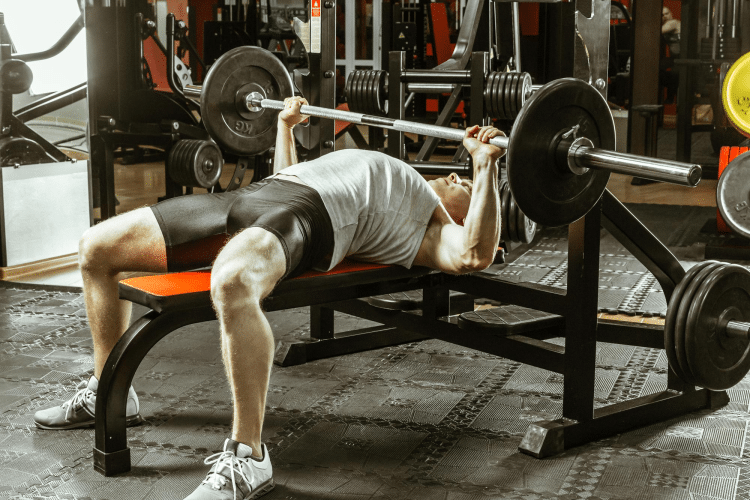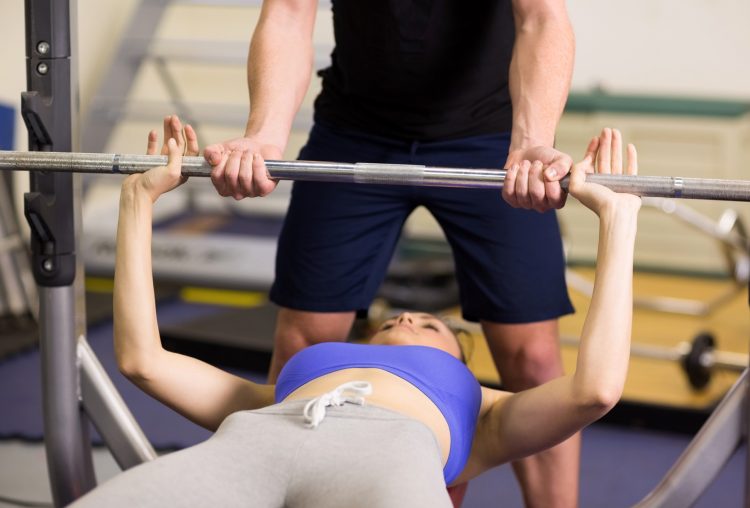Lifting weights can improve every aspect of your life; it can help build an aesthetically appealing physique, boost strength, improve overall functionality, and even reduce the risk of chronic health conditions like blood pressure and cancer. (1)
However, most lifters hit a strength and muscle plateau at some point. As a personal trainer with over 17 years of experience, I have no qualms in admitting that I’ve hit a rut multiple times during my lifting journey.
While progressive overload is key to making consistent gains, it is easier said than done. After spending 40-plus hours researching different training protocols, I arrived at the microloading method. Although I was initially skeptical about this approach, the science behind it and the results I have been able to get for myself and my clients turned me into a believer.
In this article, I share everything you need to know about the microloading method to transform your physique, including a 12-week experiment.
My 12-Week Microloading Experiment

Now that you understand the basics of the microloading approach, it is time to dive deep into the specifics:
Level Up Your Fitness: Join our 💪 strong community in Fitness Volt Newsletter. Get daily inspiration, expert-backed workouts, nutrition tips, the latest in strength sports, and the support you need to reach your goals. Subscribe for free!
My Starting Points
Here are the specifics of my four main lifts:
- Squat: 315 pounds
- Bench Press: 225 pounds
- Deadlift: 405 pounds
- Overhead Press: 185 pounds
How To Microload?
You could progressively overload your muscles using magnetic microplates or fractional plates (less than 1 pound). If your gym doesn’t have these microweights, you can find them for cheap in most fitness stores or online. These are a great way to make small weight increases that standard weight plates don’t allow.
Weekly Progress With The Microload Method
Below is a detailed summary of my gains:
Week One
I added 100 grams (0.22 pounds) to each lift. To be honest, I didn’t even feel the additional weight in the first week. In retrospect, this is the whole point of the microloading method. You are making progress without overwhelming your brain or muscles.
Since we are only adding 100 grams per week, the week-to-week changes weren’t dramatic. However, the overall progress from Week One to 12 was nothing short of magical.
Week Two
While the first 100-gram jump didn’t really register, I started feeling the extra weight in the second week, especially on the bench press, which is one of my weaker lifts. I highly recommend getting a spotter for these microload sets, as you are technically attempting a PR in each set.
Week Three
Another 100-gram jump. This time, I hit multiple sticking points on the bench press, while the other three lifts were relatively smooth. That said, the bar moved a bit slower on all four lifts.
Week Four
The fourth week was when I started noticing some progress. My squat felt strong, and I added an extra rep to my top set. I also saw a reduction in the sticking points, and my spotter told me I didn’t need as much help on the lifts compared to the previous week.
Week Five
The fifth week was monumental, as I was up 500 grams from where I started. This is also when I stagnated on the overhead press. To work on my lockout strength, I added floor presses to my accessory lifts.
Week Six
I hadn’t planned this initially, but I decided to do a deload week to give my body some break. I used a 10 percent deload on all lifts and felt incredible by the end of the week.
Week Seven
In Week Seven, I had 600 additional grams on the bar from where I started. I managed a PR on each lift with little to no support from my training partner.
Week Eight
I decided to do more reps in most exercises, and I was definitely gaining strength. Remember, the numbers presented above are not 1RM (one-rep maxes). For example, I could squat 315 pounds for a triple and deadlift 405 for a double. You must establish your own benchmarks and work with them.
Week Nine
For me, Week Nine was the highlight of this program. I finally felt stronger on the bench press, and the bar moved like butter. There were no sticking points whatsoever.
Week 10
To make things more interesting, I increased my training volume by doing more sets and reps per exercise. I definitely felt the effects on the third day of this week. I was sore, which marginally impacted my performance for the final three days of training.
Week 11
Another deload week. I focused on mobility and pliability to improve overall functionality. I also did an additional 10-minute cardio workout to improve my muscle conditioning.
Week 12
I was super stocked for the final week and went all-out on everything, achieving a PR in every lift I attempted.
Who Should Use Microloading?

Like most training protocols, microloading isn’t for everyone. This method solves a specific purpose for a particular type of lifter. Let’s understand who stands to gain the most from incorporating this training technique into their regime and who should avoid it:
Level Up Your Fitness: Join our 💪 strong community in Fitness Volt Newsletter. Get daily inspiration, expert-backed workouts, nutrition tips, the latest in strength sports, and the support you need to reach your goals. Subscribe for free!
Ideal Candidates
The following folks should add this principle to their routine:
Lifters Dealing With a Plateau
Making big jumps in weights to unlock new gains can be almost impossible for experienced lifters. This is where microloading and adding small amounts of weight to the bar shine.
The Patient Gainer
Crafting a Greek god physique is a long-term goal. Most lifters in this lifestyle value steady, sustainable progress, and microloading is the right step forward for them.
Athletes Fine-Tuning Their Training
I have clients who love to track each detail of their training regime. They are always curious if small increments in training volume can be as effective as big jumps. The microloading method can help them decode this.
People Trying To Avoid Injury
Many gym injuries don’t happen out of the blue. They are often preceded by muscle, tendon, joint, or ligament aches or pains. You must learn to listen to your body and understand these cues. Microloading can give your muscles the time and space to recover while avoiding plateaus.
Who Should Avoid Microloading
The following people can omit this training method:
Beginners
Novice lifters must focus on mastering the correct lifting technique and building a solid foundation. Then, aim to maximize the newbie gains by lifting progressively heavier weights. Microloading can come later.
People Who Want Quick Results
Folks who want quick results should avoid the microloading path, as it can take anywhere between 12-24 weeks to see the desired results.
Elite Athletes
Pro-level athletes usually need specialized training strategies to maximize their gains, and the microloading method might not cut it by itself.
Remember, microloading isn’t a magic bullet. Its effectiveness and results will depend on your training experience and goals. I recommend beginners consult with a professional to determine if this is the right approach for them.
How to Implement Microloading in Your Training
Use these simple steps to incorporate microloading into your training:
- Start Small: It is called a microload for a reason. Pick the smallest incremental weight available to you. While 50-100 grams is a good place to start, there is no harm in starting with something even smaller.
- Track Your Progress: Keep a workout log to monitor your training volume and overall progress. This data can help ensure consistent progress.
- Listen To Your Body: Microloads are meant to push your limits. However, you shouldn’t sacrifice your form. Reconsider the overload if you feel undue joint or muscle pain.
- Choose Your Battles: You could use the microloading principle on any exercise, but it works best for compound lifts like squats, deadlifts, and bench presses.
- Periodize Your Program: Avoid microloading endlessly. Begin with an end in mind and have a deload weak every four to six weeks to give your body ample time to recover.
The Science Behind Microloading
Hitting a plateau in the gym can make you feel pretty hopeless. I had recently arrived at a point where I was pushing with everything I had got, but the weights wouldn’t budge, and this continued for multiple weeks.
Situations like these can drain your motivation, tempting you to give up before achieving your objectives.
This was when I decided to introduce microloading into my routine to progressively overload my muscles. I’ll be honest: the idea of adding a tiny amount of weight (100 grams per week) to the bar initially sounded silly to me. However, it opened new doors for me once I dropped my ego.
Microloading works by consistently nudging your body and increasing the total training volume. The additional weight is not so much that it overwhelms you and increases injury risk, but it is just enough to shock your muscles and promote favorable adaptations.
Neuromuscular Adaptations
Most people think about progressive overloading in isolation as a physiological concept. However, it is much more than that. Progressive overload triggers neuromuscular adaptations, which is a fancy way of saying that your brain and muscles are getting better at working together.
Once you add the 100 grams to the bar, your brain registers the additional challenge, and your muscles respond by getting stronger.
The new strength and the belief that you can lift heavier weights can be a game changer for your self-confidence. The microloading method allows you to stack consistent wins, as you’ll lift heavier each week. It will also motivate you to stick with your workouts for the long term.
Microloading vs. Traditional Progression
It is only natural to wonder how microloading compares to traditional progression and if it is even worth your time. While both approaches work, they have different strengths:
- Traditional Approach: The conventional progression approach is excellent for beginners and those with plenty of room for growth. The newbie gains are for real, and you can add a significant amount of weight to your lifts in a short period without feeling overwhelmed.
- Microloading: Lifting heavier can get increasingly challenging as you gain more experience. Most lifters hit a sticking point at some point during their career. Microloading is a more sustainable approach for experienced lifters to make consistent progress in the long term.
Conclusion
The microloading method involved adding 100 grams to your lifts per week. While this might not sound like a lot of weight, it is just enough to progressively overload your muscles each week and ignite new strength and muscle gains.
If you have any questions about the microloading method or need help implementing it into your training regime, drop them in the comments below, and I’ll be happy to help!
References:
- Mazzilli, K. M., Matthews, C. E., Salerno, E. A., & Moore, S. C. (2019). Weight Training and Risk of 10 Common Types of Cancer. Medicine and science in sports and exercise, 51(9), 1845–1851. https://doi.org/10.1249/MSS.0000000000001987




